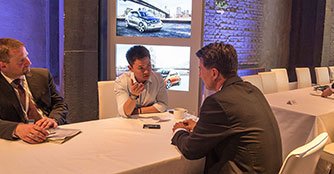The visionary insight of the BMW i3
12 Aug 2013|10,975 views
Mr. Harald Kruger (HK) - Member of the Board of Management of BMW AG, Production - is, by all accounts, a busy man. A rather tall man (as most Germans are), he stands about some 1.8 metres tall, with nicely combed hair, a prominent nose and a neatly tailored suit. More importantly and relevantly, he remains humble and finds time for a quick chat despite finishing countless interviews from the media. He walks over, gives a firm handshake, sits down and jokes about how prepared I already am as he points to the expresso I have on the table.
SGCM: Automotive designs have always been on the point of meeting form with function. Were there any compromises for technology in lieu of such a small car design?
HK: No, there were no compromises as we said that we were going to develop a revolutionary car. This is not a vehicle that was converted from a regular to an electric car. We did everything from scratch starting in 2006 - 2007. We made use of carbon fibre to have more design freedom because materials like plastic and steel have a limit to how much you can bend it. That's why the designer loves it! There's also ample space all round becasue there's no transmission tunnel. Plus, the gear lever is no longer located at the centre console so this clears up a lot of space. It's a revolution in the manufacturing process and the design.
SGCM: What were the factors that were taken into consideration when planning for the BMW i3?
HK: First, very clear, we wanted to design a car for people who are driving in megacites. So there must be enough space for four adults. Second, it should be a pure electric vehicle. The third factor is we wanted to design something with new materials that never existed before. Electric vehicles have batteries that are way too heavy and we needed something to counter this problem with an even lighter body and lighter chassis. Hence, we went with the LifeDrive concept with the aluminium chassis and carbon fibre body because these materials are very light. This enhances the car's dynamic qualities. The fourth one was sustainability in every aspect. That's why the aim was 50% less energy and 70% less water consumption in the manufacturing process.
SGCM: Considering the i3 is based on LifeDrive where Life is a variable component that can be altered or redesigned as needed, will we be expecting to see more variants of the i3 in the near future?
HK: The possibility is there as it's design that way. But the next hot product is the BMW i8. That will be the next surprise. It's a plug-in hybrid and a true sports car with a fuel consumption of a small car. You can even drive it in certain areas in pure electric mode too.
 |
SGCM: Can you describe to me the audience intended for the BMW i3?
HK: The BMW i3 is targeted at new customers to the brand who are looking for a lifestyle of sustainability and health and are looking for an electric vehicle but never had a premium offer in this segment. It's also targeted at customers who are looking for a second car to drive in megacities. Typically, young people who love life will enjoy the i3. If you're at the lights, you will leave the Porsche behind because the torque is readily available. So that's the kind of fun young people will enjoy.
SGCM: What are your views on electric cars such as the i3 taking on the petrol/diesel-driven cars from BMW to become the automobiles of the future?
HK: This is visionary of mobility and you will find more and more electric vehicles in the future for sure. If you look at the problems in the city, it's poor air quality and sometimes noise and you can only resolve these problems with electric vehicles. Of course the car cannot compromise fun and driving pleasure. But this is definitely the future.
SGCM: In 2007, Project i started. That was when MINI E and BMW ActiveE began. When both these cars were made, you guys already had the BMW i in mind?
HK: Yes. The MINI E and BMW ActiveE were part of the development phase. That's why we started with the conversion like the MINI E as we wanted to experience how an electric drivetrain works. Plus, we wanted to do millions of test kilometres to see what customers expect. That's how we derived that 130km to 160km per day of driving in an electric vehicle is a reasonable distance. These were part of the long-term development for the BMW i.
Mr. Harald Kruger (HK) - Member of the Board of Management of BMW AG, Production - is, by all accounts, a busy man. A rather tall man (as most Germans are), he stands about some 1.8 metres tall, with nicely combed hair, a prominent nose and a neatly tailored suit. More importantly and relevantly, he remains humble and finds time for a quick chat despite finishing countless interviews from the media. He walks over, gives a firm handshake, sits down and jokes about how prepared I already am as he points to the expresso I have on the table.
SGCM: Automotive designs have always been on the point of meeting form with function. Were there any compromises for technology in lieu of such a small car design?
HK: No, there were no compromises as we said that we were going to develop a revolutionary car. This is not a vehicle that was converted from a regular to an electric car. We did everything from scratch starting in 2006 - 2007. We made use of carbon fibre to have more design freedom because materials like plastic and steel have a limit to how much you can bend it. That's why the designer loves it! There's also ample space all round becasue there's no transmission tunnel. Plus, the gear lever is no longer located at the centre console so this clears up a lot of space. It's a revolution in the manufacturing process and the design.
SGCM: What were the factors that were taken into consideration when planning for the BMW i3?
HK: First, very clear, we wanted to design a car for people who are driving in megacites. So there must be enough space for four adults. Second, it should be a pure electric vehicle. The third factor is we wanted to design something with new materials that never existed before. Electric vehicles have batteries that are way too heavy and we needed something to counter this problem with an even lighter body and lighter chassis. Hence, we went with the LifeDrive concept with the aluminium chassis and carbon fibre body because these materials are very light. This enhances the car's dynamic qualities. The fourth one was sustainability in every aspect. That's why the aim was 50% less energy and 70% less water consumption in the manufacturing process.
SGCM: Considering the i3 is based on LifeDrive where Life is a variable component that can be altered or redesigned as needed, will we be expecting to see more variants of the i3 in the near future?
HK: The possibility is there as it's design that way. But the next hot product is the BMW i8. That will be the next surprise. It's a plug-in hybrid and a true sports car with a fuel consumption of a small car. You can even drive it in certain areas in pure electric mode too.
SGCM: Can you describe to me the audience intended for the BMW i3?
HK: The BMW i3 is targeted at new customers to the brand who are looking for a lifestyle of sustainability and health and are looking for an electric vehicle but never had a premium offer in this segment. It's also targeted at customers who are looking for a second car to drive in megacities. Typically, young people who love life will enjoy the i3. If you're at the lights, you will leave the Porsche behind because the torque is readily available. So that's the kind of fun young people will enjoy.
SGCM: What are your views on electric cars such as the i3 taking on the petrol/diesel-driven cars from BMW to become the automobiles of the future?
HK: This is visionary of mobility and you will find more and more electric vehicles in the future for sure. If you look at the problems in the city, it's poor air quality and sometimes noise and you can only resolve these problems with electric vehicles. Of course the car cannot compromise fun and driving pleasure. But this is definitely the future.
SGCM: In 2007, Project i started. That was when MINI E and BMW ActiveE began. When both these cars were made, you guys already had the BMW i in mind?
HK: Yes. The MINI E and BMW ActiveE were part of the development phase. That's why we started with the conversion like the MINI E as we wanted to experience how an electric drivetrain works. Plus, we wanted to do millions of test kilometres to see what customers expect. That's how we derived that 130km to 160km per day of driving in an electric vehicle is a reasonable distance. These were part of the long-term development for the BMW i.
Thank You For Your Subscription.

























